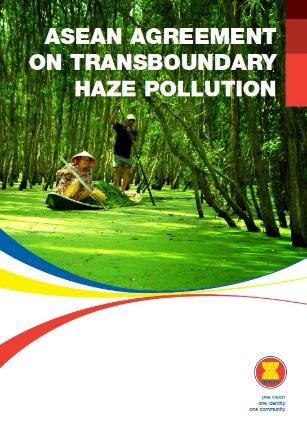ASEAN Agreement on Transboundary Haze Pollution (AATHP)
In 1999, ASEAN took a step further by adopting the policy on zero burning. In October 2000, the Environment Ministers agreed to forge ahead with the formulation of an ASEAN Agreement on Transboundary Haze Pollution (AATHP) and an intergovernmental committee was formed to draft the Agreement. The Agreement aims to further operationalize and institutionalize existing arrangements in addressing transboundary haze pollution. It calls for parties of the Agreement to undertake:
- Legislative and administrative measures to prevent and control activities related to land and forest fires that may result in transboundary haze pollution; and
- National and joint actions to intensify regional and international cooperation to address transboundary haze
The Agreement also seeks to formalize mechanisms for communication and sharing of information on land forest fires and the resulting transboundary haze pollution through the establishment of an ASEAN Centre for Transboundary Haze Pollution Control. The AATHP was signed by ten member countries of ASEAN on 10 June 2002 in Kuala Lumpur during the World Conference and Exhibition on Land and Forest Fire Hazards. The Agreement is one of the first such regional arrangements in the world that binds a group of contiguous states to tackle transboundary haze pollution resulting from land and forest fires. The ASEAN Ministers responsible for environment agreed to work towards ratifying the AATHP as soon as possible to ensure the regional efforts are further enhanced through the legal mechanisms provided for in the Agreement. The Agreement requires at least six ratifications to enter into force. The AATHP finally came into force on the 25 November 2003 and Indonesia deposited the instrument of ratification on 20 January 2015.
Basically, the objective of the Agreement is to prevent and monitor transboundary haze pollution as of result of land and/or forest fires which should be mitigated, through concerted national efforts and intensified regional and international cooperation. The Agreement itself focuses on matters regarding monitoring, assessment and prevention of transboundary haze and the kind of technical cooperation. R&D and institutional arrangement required in order to meet the objectives of the Agreement.
Here is the list of institutional arrangements under AATHP to discuss urgent measures to jointly tackle the common problems caused by transboundary haze pollution:
- Conference of the Parties (COP)
- Ministers level – Overall direction, reviews and evaluates implementation; and
- Meets annually.
- Committee under COP
- Senior Officials level – Meets annually prior to COP meetings.
- MSC & MSC Mekong
- sub-regional cooperation on transboundary haze pollution (MSC – southern ASEAN; MSC Mekong – northern ASEAN);
- Meets once a year or more as necessary; and
- Supported by a Technical Working Group.
- ASEAN Task Force on Peatlands
- Established in 2015 to oversee the design and the implementation of the ASEAN Programme on Sustainable Management of Peatland Ecosystems (2014-2020) (APSMPE) and other relevant programs/projects and facilitate cooperation with relevant partners.
- ASEAN Coordinating Centre for Transboundary Haze Pollution Control (ACC)
- To be hosted by Indonesia, discussions on establishment of the Centre are ongoing; and
- Currently performed by ASEAN Secretariat and ASEAN Specialised Meteorological Centre (ASMC).
- ASEAN Haze Fund
- Voluntary contributions from the Parties, open to contributions from other sources subject to approval by the Parties.






